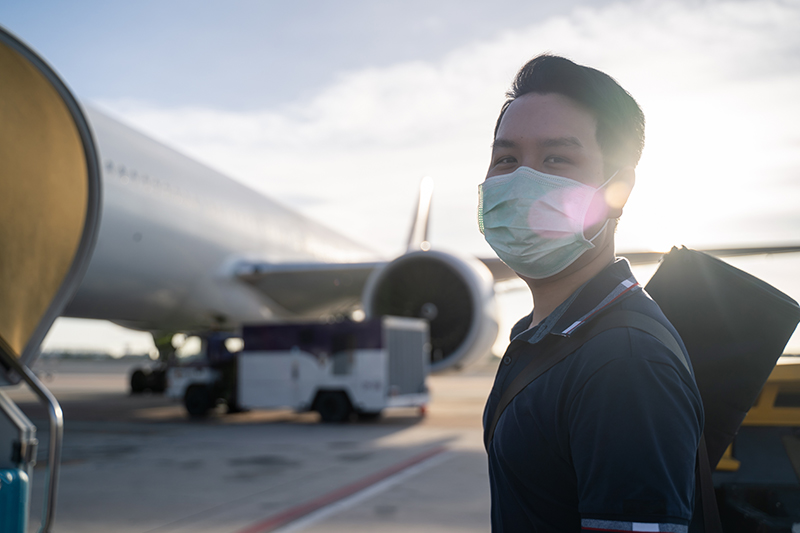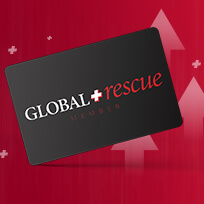Our in-house operations teams are closely monitoring ongoing developments.
October 1 – Canada has returned to Pre-COVID-19 border restrictions. The following changes have occurred:
- Canadian officals no longer track vaccination status.
- Canadian officials no longer require PCR or antigen test results.
- Canadian officials no longer conduct health screening upon arrival at port of entry.
- Registration in Canada’s electronic tracking system, ArriveCAN, is optional.
- The Canadian Government recommends but does not require masks on airlines and public transportation.
August 23 – CDC updated COVID-19 guidance in August 2022, recommending that people exposed to COVID-19 wear a high-quality mask for 10 days and get tested on day 5. Quarantining is no longer recommended or necessary. You should isolate, regardless of vaccination status, if:
- You have COVID-19.
- You are sick and suspect that you have COVID-19 but do not yet have test results.
- When test results are negative, you can end your isolation.
CDC recommends that if you test positive for COVID-19:
- You stay home for at least 5 days and isolate from others in your home. You are likely most infectious during these first 5 days.
- You should wear a high-quality mask when you must be around others at home or in public.
- If, after 5 days you are fever-free for 24 hours without the use of medication, and your symptoms are improving, or you never had symptoms, you may end isolation after day 5.
- You should avoid being around people who are more likely to get very sick from COVID-19 until at least day 11.
- You should wear a high-quality mask through day 10.
- If you had moderate illness (if you experienced shortness of breath or had difficulty breathing) or severe illness (you were hospitalized) due to COVID-19 or you have a weakened immune system, you should isolate through day 10.
- If you had a severe illness or have a weakened immune system, consult your doctor before ending isolation.
- Ending isolation without a viral test may not be an option for you. If you are unsure if your symptoms are moderate or severe or if you have a weakened immune system, talk to a health care provider for further guidance.
- After you have ended isolation, if COVID-19 symptoms worsen, restart your isolation at day 0. Talk to a health care provider if you have questions about your symptoms or when to end isolation.
July 26 – Canada has moved random mandatory testing out of airports at Toronto Pearson, Vancouver, Calgary and Montréal-Trudeau airports. Travelers arriving in Canada selected for random testing will receive an email within 15 minutes of completing their customs declaration to test either via an in-person appointment at select testing provider locations and pharmacies or a virtual appointment for a self-swab test.
CDC’s COVID-19 Program for Cruise Ships is no longer in effect. CDC will continue to publish guidance to help cruise ships continue to provide a safer and healthier environment for passengers, crew and communities.
Canada:
- As of October 1st 2022, Canada has returned to pre-COVID-19 border restrictions. The following changes occured:
- Canadian officals no longer track vaccination status.
- Canadian officials no longer require PCR or antigen test results.
- Canadian officials no longer conduct health screening upon arrival at port of entry.
- Registration in Canada’s electronic tracking system, ArriveCAN, is optional.
- The Canadian Government recommends but does not require masks on airlines and public transportation.
European Union:
- The European Council, a non-legislative body that defines the EU’s overall political direction and priorities, removed the US from their list of epidemiologically safe countries. In doing so, the council issued a non-binding recommendation for member states to update entry restrictions for travelers from the US.
- Since the guidance is non-binding, member states will make their own decisions on which travelers may enter from the US.
- Some member states may close to unvaccinated US travelers only, while others might close to all US travelers.
- EU approved vaccinations include Comirnaty (Pfizer), COVID-19 Vaccine Moderna, Vaxzevria (previously COVID-19 Vaccine AstraZeneca), and COVID-19 Vaccine Janssen (Johnson and Johnson).
- Exactly what constitutes proof of vaccination has not been universally established and appears to vary from country to country. US CDC vaccination cards may or may not be sufficient. We recommend you check with your airlines for a determination.
United Kingdom:
-
- Travelers aged 12 and over, regardless of vaccination status, must show proof of a negative PCR test taken within 48 hours of departure for the UK.
- UK citizens and residents who have been in the prohibited countries within the last ten days must book a quarantine hotel package for ten nights. The package must include two COVID-19 tests.
-
- A number of countries have changed entry requirements for travelers originating in or traveling through the UK to include additional testing requirements, self-isolation rules, and mandated quarantines.
- Some countries have prohibited passenger flights and/or travelers whose travel originates in the UK (with exceptions such as citizenship). Please check with your airlines to see if flights are possible from the UK to your preferred destination.
United States Government Guidance
The Department of State currently advises all U.S. citizens to read the country-specific DOS Travel Advisories. DoS Travel Advisories can be accessed here. An interactive map is posted here.
Most US embassies are providing passport and visa services on a non-emergency basis.
DoS is conducting a three-phase reopening of passport agencies and centers in the US. A list of the agencies and their current phase of reopening is available here.
US Citizenship and Immigration Services (USCIS) resumed in-person services on 4 June. Further information is available here.
CDC Cruise Ship Guidance
As of July 18, 2022, CDC’s COVID-19 Program for Cruise Ships is no longer in effect. CDC will continue to publish guidance to help cruise ships continue to provide a safer and healthier environment for passengers, crew and communities. Guidance can be found here.
Eventual Ease of Travel Advisories and Restrictions
- For US Travelers: When CDC and DoS begin to change travel advisories levels, they will likely do so on a country by country basis, taking a number of factors into consideration including COVID-19 infection rates in the destination country, testing/reporting status, quality of medical care, regional rates of infection, and the potential for travelers to bring coronavirus back into the US.
- Destination countries will continue to impose various levels of restrictive measures in an attempt to keep infection and reinfection rates low.
References
The following sources provide additional information related to guidelines and advice for the general public, as well as US Department of State travel advisory information and two sources for case tracking.
- Centers for Disease Control and Prevention Coronavirus Guidelines
- WHO Coronavirus Guidelines
- US Department of State Travel Advisories
- Johns Hopkins University Case Tracker
- BBC Pandemic Tracking
- Schengen Area Information
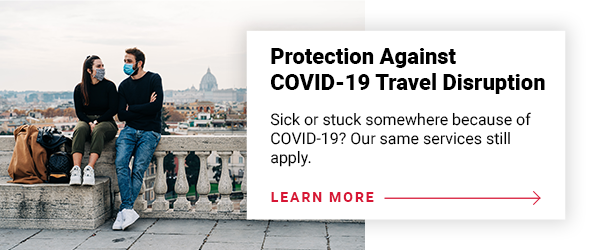
United States Entry Restrictions
On 12 January 2021, CDC issued an order requiring a negative pre-departure COVID-19 test result or documentation of recovery from COVID-19 for all airline or other aircraft passengers arriving into the United States from any foreign country. The effective date is 26 January. The order makes no distinctions between citizens, non-citizens, residents, or non-residents.
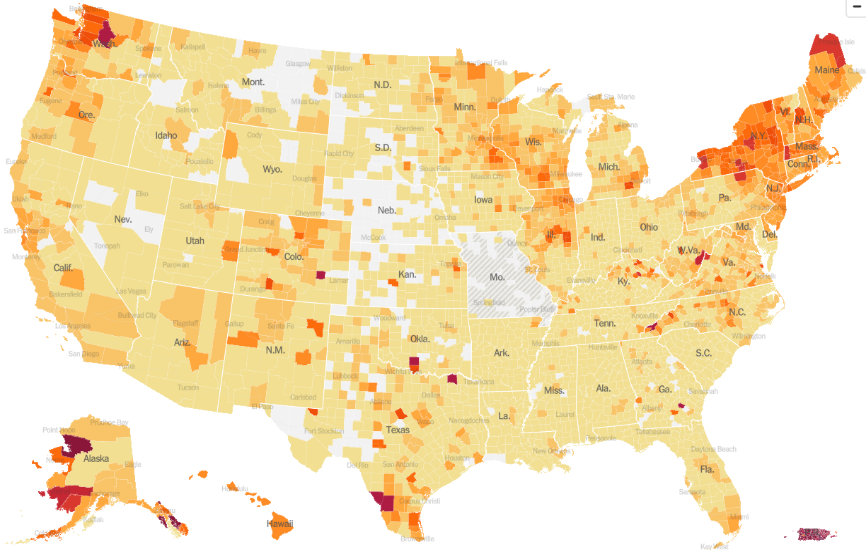 Legend: Few or no cases | Falling | About the Same | Slowly Rising | Moderate Rise | Rising Quickly | Record Highs
Legend: Few or no cases | Falling | About the Same | Slowly Rising | Moderate Rise | Rising Quickly | Record Highs
*Map courtesy of the New York Times
International Restrictions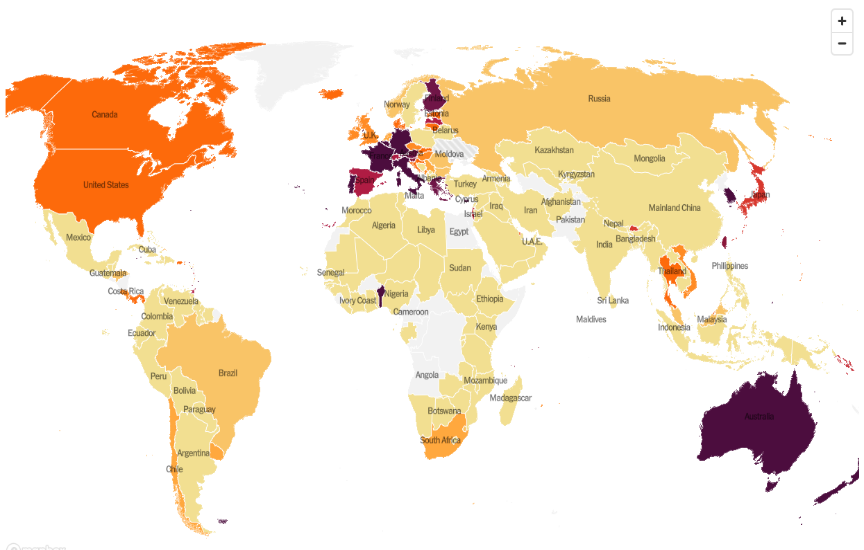
*Map courtesy of the New York Times
To view country specific restrictions click below
VIEW INTERNATIONAL RESTRICTIONS
A note for the country restrictions matrix: The category of “Lockdowns, Curfews, or Stay‐at‐Home Orders” includes any government‐imposed measure that grants authority to security personnel to prevent people from leaving the home, bans nonessential movement, restricts entry or exit from certain areas, limits the use of private transportation, or imposes other restrictions on movement. Not included in this category are measures such as closures of parks or certain businesses, bans on mass gatherings, and “safer‐at‐home” orders which are not enforced.Countries are now arranged alphabetically within the following regional groupings:
- Africa
- Asia
- Australia and Oceania
- Central and South America
- Europe
- Middle East
- North America and Caribbean
Each country is now assigned a Travel Restriction Status (first column). Status definitions are:
- R=Red Status – Fully Closed Nation – all borders closed to non-citizens or non-residents. No routine crossing of borders allowed except for commerce and medical support.
- Y=Yellow Status – Partially Open Nation – entry allowed to some or all non-citizens or non-residents. COVID-19 restrictions are in place but may be easing.
- G=Green Status – Fully Open Nation – no travel restrictions in place they were not in existence prior to the COVID-19 pandemic.
Signs and Symptoms of Novel Coronavirus (COVID-19)
The majority of cases related to this coronavirus outbreak have reported fever, cough and respiratory difficulties (distress, rapid breathing and shortness of breath).General symptoms related to coronavirus infection can also include, but are not limited to
- Runny nose
- Headache
- Cough
- Sore throat
- Fever
- Loss of smell and/or taste
- Diarrhea
- Aches and pains
- General feeling of being unwell
Medical Advice for Travelers
Avoid contact with sick people. Avoid animals (alive or dead), animal markets and products that come from animals (such as uncooked meat). Wash hands often with soap and water for at least 20 seconds. Use an alcohol-based hand sanitizer if soap and water are not available. Older travelers and those with underlying health issues may be at risk for more severe disease.
Our Coronavirus Quarantine Policies
In an attempt to control the spread of the COVID-19 outbreak, several countries including the U.S. are enforcing a mandatory 14-day quarantine for travelers who may have been exposed to the virus.
Global Rescue recommends that before departure, travelers carefully review the coronavirus control policies of their destination and defer travel if there is a chance of being quarantined. Global Rescue strongly supports the international effort to control the spread of coronavirus. If a Global Rescue member is quarantined, Global Rescue will continue to provide medical and other advisory services. However, medical evacuation is not possible during a mandated quarantine period.
* Data based on press reporting and subject to further verification.
Click below to sign up for daily alert updates.

